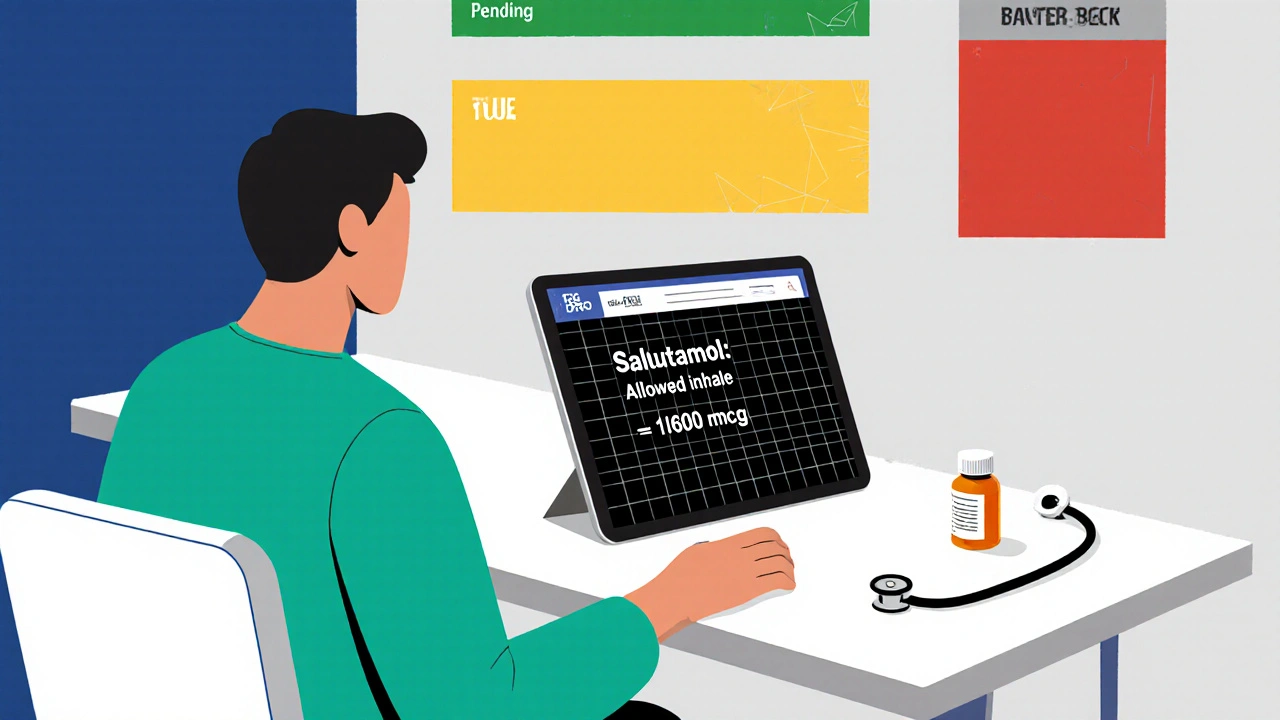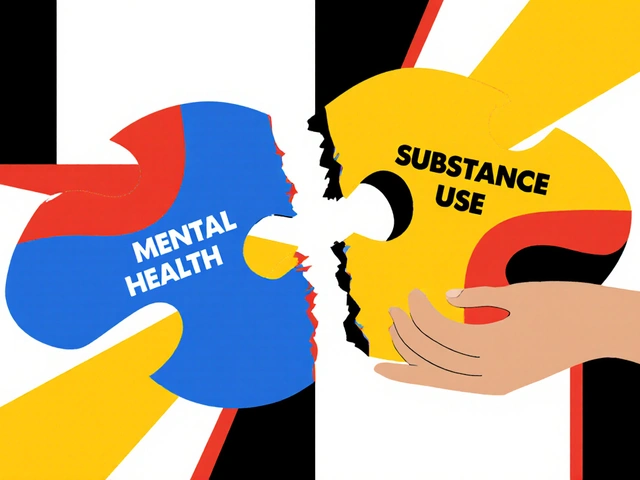Medication Safety Checker for Athletes
Check Medication Compliance
This tool helps you determine if your medication is allowed under WADA rules for your specific sport and competition status.
Every year, thousands of athletes take prescription meds to manage asthma, ADHD, diabetes, or chronic pain. But what they don’t always realize is that some of those medications could land them in serious trouble - even if they’re legally prescribed. This isn’t about cheating. It’s about understanding a system that holds athletes responsible for everything in their body, no matter how innocent the intent.
Think about it: You’re on insulin because you have type 1 diabetes. You use an inhaler for asthma. You take Adderall for ADHD. All legal. All necessary. But under the World Anti-Doping Agency (WADA) rules, these substances are either banned outright or allowed only under strict conditions. And if you don’t know that, you could test positive - even if you followed your doctor’s orders.
Why Athletes Can’t Just Take Their Prescriptions
WADA’s Prohibited List isn’t a secret. It’s updated every January and published online. But here’s the catch: just because a drug is legal to buy doesn’t mean it’s legal to use in sport. Some medications are banned at all times. Others are only banned during competition. And some are allowed - but only in specific doses or delivery methods.
For example, salbutamol - the active ingredient in Ventolin - is allowed inhaled up to 1,600 micrograms over 24 hours. But if you take it as a pill or through an IV, it’s banned. Same with corticosteroids: a topical cream for eczema is fine. A shot before a race? That’s a violation.
The system operates on strict liability. That means if a banned substance shows up in your sample, you’re responsible - even if you didn’t know it was there. A teammate shared their pill. Your doctor didn’t check. Your pharmacy didn’t flag it. Doesn’t matter. You’re still on the hook.
What Medications Are Most Likely to Cause Problems?
Based on data from WADA and USADA, the top three medications that trigger Therapeutic Use Exemption (TUE) applications are:
- Glucocorticoids (like prednisone or dexamethasone) - 28.7% of all TUEs
- Asthma medications (beta-2 agonists like salbutamol and formoterol) - 21.3%
- Growth hormone and related compounds - 12.6%
These aren’t performance enhancers in the traditional sense. For many athletes, they’re life-savers. A diabetic athlete needs insulin to survive. An asthmatic athlete can’t breathe without their inhaler. But because these substances can affect metabolism, recovery, or oxygen use, they’re closely monitored.
Side effects are another layer of risk. Long-term corticosteroid use can suppress your adrenal glands, making you vulnerable to crashes under stress. Beta-2 agonists can cause heart palpitations or tremors - not ideal before a sprint. And stimulants like Adderall? They can raise blood pressure, cause insomnia, and lead to dependence. Athletes aren’t just managing doping rules - they’re managing their own health while competing.
Therapeutic Use Exemptions (TUEs): How They Really Work
If you need a banned medication, you don’t quit. You apply for a TUE. But it’s not a rubber stamp. To get approved, you must prove four things:
- You have a diagnosed medical condition that requires the medication.
- The drug won’t give you an advantage beyond returning you to normal health.
- No permitted alternative exists.
- You applied before using it - unless it was an emergency.
International-level athletes apply through their sport’s federation. National-level athletes go through their country’s anti-doping agency. In the U.S., that’s USADA. In Australia, it’s Sport Integrity Australia. The process can take weeks. One NCAA athlete spent 11 months getting approval for Adderall - submitting three times, getting denied twice, and needing specialist letters each time.
Approval rates are high - around 94% for first-time applications in the U.S. - but denials happen. Most often, it’s because the paperwork is incomplete. Missing lab results. No diagnosis confirmation. No history of failed alternatives. If you’re applying, don’t guess. Get your doctor to help you fill out every form. Save every test result. Keep copies of everything.
Global DRO: Your Best Friend
You don’t need to memorize the Prohibited List. You don’t need to be a chemist. You just need to use Global DRO - the free, official tool that tells you if a medication is allowed in your sport, country, and form.
Go to globaldro.com (or your country’s equivalent). Select your country, sport, and whether you’re in-competition or out-of-competition. Then type in the exact name of the medication - not the brand, not the generic, but the active ingredient as it appears on the label. For example: “salbutamol,” not “Ventolin.”
It will tell you if it’s allowed, and if so, what the maximum dose is. It even tells you if the form matters - like whether a tablet is okay but an injection isn’t. Use it every time. Even if you’ve used the same med for years. Ingredients change. Dosing limits change. The rules change.

What Doctors Don’t Know (And Why It Matters)
Here’s the uncomfortable truth: many doctors don’t know the anti-doping rules. A 2022 study found that 68% of athletes said their physicians had little to no knowledge of WADA’s list. That’s not the doctor’s fault - they’re not trained in sports regulations. But it’s your responsibility to inform them.
Before your next appointment, print out the medication you’re on. Show them the Global DRO result. Tell them you’re an athlete. Ask: “Is this allowed under WADA rules?” If they’re unsure, direct them to WADA’s physician toolkit. It’s free. It’s real. And it’s designed for exactly this situation.
Doctors who understand the rules can help you find alternatives. Maybe there’s a non-banned asthma inhaler. Maybe a different painkiller. Maybe a physical therapy plan instead of a steroid shot. But they can’t help if they don’t know you’re an athlete.
Clearance Times: Don’t Wait Until Race Day
Some substances leave your body fast. Others hang around for days. If you’re taking something banned in-competition, you can’t just stop the day before your race.
Here are rough clearance times for common meds:
- Corticosteroids (oral): 48-72 hours
- Stimulants (like methylphenidate): 24-48 hours
- Beta-2 agonists (inhaled): 24-36 hours
- Insulin: No clearance needed - always permitted with TUE
These are estimates. Your metabolism, dosage, and frequency all affect clearance. Global DRO will give you the official guidance. If it says “must be stopped 72 hours before competition,” then stop it 72 hours before. Don’t test it. Don’t assume. Don’t hope.
What Happens If You Get Caught?
An anti-doping rule violation (ADRV) can mean anything from a warning to a four-year ban. It’s not just about the test. It’s about your record. Your scholarship. Your sponsorships. Your reputation.
But here’s the thing: most violations aren’t intentional. A 2023 study found that 42% of athletes who tested positive didn’t even know the medication contained a banned substance. That’s not negligence - it’s lack of awareness. And that’s exactly what the system is trying to fix.
The good news? If you follow the rules - check your meds, apply for a TUE if needed, talk to your doctor - you’re not at risk. You’re protected.

Parents and Youth Athletes: Don’t Panic
Parents often hear “anti-doping” and think, “My kid has to stop their ADHD med.” That’s not true. But they also don’t know how to navigate the system. A 2023 USADA survey found that 28% of youth athletes stopped taking necessary medications because they were scared of getting banned.
You don’t have to choose between health and sport. You just have to be informed. If your child needs insulin, asthma meds, or ADHD treatment, work with their doctor and their sport’s anti-doping body. Apply for a TUE early. Use Global DRO. Keep records. This isn’t about restriction - it’s about access.
USA Swimming had a 17-year-old swimmer with type 1 diabetes who got her TUE approved for insulin. She didn’t quit. She competed. She won. Because she did the paperwork.
Final Rule: Check. Confirm. Document.
There’s no magic trick. No shortcut. Just three steps:
- Check every medication - new or old - on Global DRO before you take it.
- Confirm with your doctor that it’s medically necessary and that no alternatives exist.
- Document everything: prescriptions, TUE applications, emails, test results. Save them.
If you do this, you’re not just following the rules. You’re protecting your health, your career, and your right to compete on your own terms. Anti-doping isn’t about suspicion. It’s about fairness. And for athletes who need medication to be healthy, it’s also about access.
The system isn’t perfect. It’s slow. It’s confusing. But it’s designed to let you compete - if you play by the rules. And those rules are there to protect you, not punish you.
Can I use my asthma inhaler if I’m an athlete?
Yes - but only if it’s inhaled and within the allowed dose. Salbutamol (Ventolin) is permitted up to 1,600 micrograms over 24 hours. Formoterol is allowed up to 54 micrograms over 24 hours. Oral or IV forms are banned. Always check Global DRO for your specific product and confirm with your doctor. You may need a TUE if you exceed limits or use a different delivery method.
Do I need a TUE for insulin if I have diabetes?
Yes. Insulin is a prohibited substance under WADA’s rules, even though it’s life-saving for people with diabetes. You must apply for a TUE before using it in competition. The process requires documentation from your endocrinologist showing your diagnosis, treatment history, and insulin regimen. Once approved, you can use insulin safely without violating anti-doping rules.
What if my doctor prescribes a banned medication?
Your doctor may not know the anti-doping rules. Don’t take the medication until you’ve checked it on Global DRO. If it’s banned, ask your doctor for a permitted alternative. If none exists, apply for a TUE immediately. Never assume a prescription is safe just because it’s legal to buy. Athletes are responsible for what they take - regardless of who prescribed it.
How long does a TUE application take?
For international athletes, applications to their federation are typically processed within 21 days. National-level athletes in the U.S. and Australia usually get a decision in 18-21 days. Emergency TUEs can be approved within 72 hours. Apply early - don’t wait until the day before a competition. Delays happen. Incomplete paperwork causes most rejections.
Can I use over-the-counter supplements safely?
No - not without checking. Many OTC supplements contain banned substances not listed on the label. A 2023 study found that 1 in 5 supplements sold in gyms contained undeclared steroids or stimulants. Even “natural” products can be contaminated. Use only products certified by third-party programs like Informed-Sport or NSF Certified for Sport. Never rely on marketing claims.
What if I’m a recreational athlete, not elite?
If you’re registered with a national governing body - even for amateur competition - you’re still subject to anti-doping rules. Many local races, triathlons, and university leagues test athletes. If you take any medication, you must check it on Global DRO. If you’re in a testing pool, you need a TUE. If you’re not, you still risk a violation if you’re selected for testing. The rules apply to everyone who competes.
Next Steps for Athletes
If you’re taking any prescription or OTC medication, do this now:
- Go to globaldro.com and search every medication you use.
- Print the results and show them to your doctor.
- If anything is banned or restricted, contact your national anti-doping agency to start a TUE application.
- Keep a folder with all your medical records, prescriptions, and TUE documents.
- Check again every January - the Prohibited List updates yearly.
You don’t have to choose between being healthy and being an athlete. You just have to be smart about it. The rules exist to protect you. Use them.






Laurie Sala
November 23, 2025 AT 03:30Okay, but like… why is this even a thing?? I mean, I get it, cheating is bad, but if I need insulin to not die, why am I jumping through hoops like I’m in some dystopian spy movie?? I’ve seen athletes cry in interviews because they got banned for a medication their doctor prescribed-like, what even is justice here??
And don’t even get me started on the paperwork!! I had to fill out seven forms just to get my thyroid meds refilled last year-now you want me to submit a dissertation just to breathe??
Global DRO? Sure, it’s great-but what if you’re on a train with no Wi-Fi and your inhaler runs out?? Do you just… stop breathing until you get home??
And why do doctors get a pass?? My PCP looked at me like I was speaking Klingon when I asked if Adderall was banned. Like, I’m the one getting tested, not them!!
I’m not saying the rules are wrong-I’m saying the system is broken. It’s like they built a firewall with holes the size of a bus, then blamed the user for driving through it.
And why is it always the athletes who get punished?? Not the pharmacy that didn’t flag it. Not the coach who didn’t educate. Not the federation that didn’t send a memo. Just… the kid who’s trying to stay alive while winning a race.
I’ve got a friend who’s a Division III runner with type 1 diabetes. She got denied her TUE because her endocrinologist used the wrong font on the form. I’m not kidding. FONT.
They say it’s about fairness. But fairness shouldn’t require a law degree and a medical degree and a PhD in bureaucratic archaeology.
I’m not anti-doping. I’m pro-human. And if you’re trying to survive and compete at the same time, you deserve better than this.
Also, can we PLEASE make Global DRO a mobile app?? I don’t want to be Googling “salbutamol WADA” while sprinting to the starting line.
Bryson Carroll
November 24, 2025 AT 08:13Look this is basic science if you're competing at any level you need to know what's in your body period end of story
Its not the system's job to babysit you
If you can't handle the rules then don't compete
Simple
Stop acting like a victim because you're too lazy to read a website
Global DRO takes 90 seconds
Thats it
And if your doctor doesn't know the rules then fire them
There are sports medicine specialists for a reason
Stop making everything about emotion and start thinking like an athlete
And no I'm not being harsh I'm being realistic
Lisa Lee
November 24, 2025 AT 17:40Canada doesn't have this problem because we actually regulate our damn pharmaceuticals
Here in the US you can buy anything from a gas station and half of it's laced with steroids
Why are we letting American pharmacies be the wild west
My cousin ran track in Toronto and never once had to deal with this nonsense
They just give you the meds and you're done
USA is the problem not the athletes
Fix your healthcare system before you lecture us on doping
Also WADA is just a tool for rich countries to keep poor athletes out
Look at the stats
Most TUE denials are from Global South countries
It's colonialism with a stopwatch
Suzan Wanjiru
November 25, 2025 AT 03:51As a former NCAA athlete with asthma I can confirm this whole post is spot on
Salbutamol limit is 1600mcg over 24 hours but if you use your inhaler 4 times in 8 hours that's 800mcg and you're already halfway there
Most people don't realize you can't just puff it whenever you feel like it
And yes doctors are clueless
I had mine prescribe me a nebulizer solution that was banned because the label said 'albuterol' not 'salbutamol'
Global DRO saved me
But you have to search by active ingredient not brand
And always double check the form
Tablet vs inhaler matters
And if you're on a TUE never stop taking your meds without checking with your doping control officer
I had a teammate get flagged because she skipped her steroid dose the day before a meet thinking she was being smart
Turns out the clearance time was 72 hours not 24
So yeah check check check
And keep copies
Everything
Kezia Katherine Lewis
November 25, 2025 AT 17:46From a sports medicine policy perspective this is a textbook case of regulatory asymmetry
The WADA framework operates under a principle of strict liability which is legally sound but ethically fraught when applied to chronic illness management
The TUE process was designed as a harm-reduction mechanism but has become a gatekeeping apparatus due to inconsistent implementation across jurisdictions
What's particularly concerning is the cognitive load placed on athletes who are already managing comorbidities
The fact that 68% of physicians lack WADA literacy indicates a systemic failure in interprofessional education
Global DRO is an excellent first-order intervention but lacks integration with EHR systems
Future iterations should include API-based validation with pharmacy databases
Additionally the 94% approval rate masks regional disparities
Low-income athletes face higher procedural barriers despite identical medical need
This isn't about cheating
It's about equitable access to therapeutic autonomy
The system should be designed to enable not exclude
JD Mette
November 27, 2025 AT 09:16I appreciate this post a lot
It's easy to judge from the outside
But I've seen friends lose scholarships over this
One guy had to stop his ADHD med and his grades crashed
He couldn't focus
He wasn't trying to cheat
He just wanted to be normal
And now he's not even competing anymore
That's the real loss
Not the medal
It's not about rules being wrong
It's about how we make people follow them
Maybe the system needs more empathy
Not just more forms
Olanrewaju Jeph
November 28, 2025 AT 10:34As a former national-level athlete from Nigeria I want to say this
The system is flawed but not because it is unfair
It is flawed because it is not accessible
In my country we had no access to Global DRO until 2020
Our anti-doping agency had no website
Doctors did not know what WADA was
I had to email WADA directly to ask about my asthma inhaler
They replied in 14 days
My competition was in 10
I competed anyway
I passed the test
But I should not have had to risk it
This is not about privilege
This is about infrastructure
Until every athlete from every country can access the same information with the same ease
The system will always be unjust
Not because of the rules
But because of the silence around them
Dalton Adams
November 30, 2025 AT 04:54Look I've read every word of this and I'm gonna break it down for you
WADA is not the enemy
The real enemy is the delusional athlete who thinks their prescription is sacred
Insulin? Fine
But you still need a TUE
It's not about suspicion
It's about standardization
Global DRO is free
It's on your phone
It takes 90 seconds
If you can't do that
You don't deserve to compete
And yes your doctor should know
But guess what? They don't
So you become your own advocate
Or you sit out
Simple
And don't get me started on OTC supplements
That's pure laziness
You think 'natural' means safe?
My cousin took a 'pre-workout' that had DMAA in it
He got a 2-year ban
Turns out it was in the 'proprietary blend'
Which means it wasn't even listed
So you want to know the real problem?
It's not the rules
It's the people who think rules don't apply to them
And if you're one of them
Then you're not an athlete
You're just a guy who wants to win
And that's not fair
And I'm not sorry